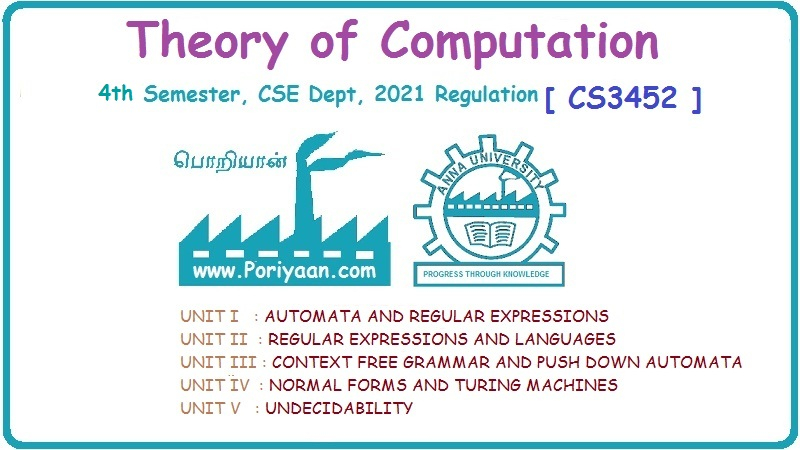Theory of Computation: Unit I: Automata and Regular Expressions
Equivalence of NFA with ε to DFA
Automata and Regular Expressions - Theory of Computation
We have to convert this NFA with ε to equivalent DFA
Equivalence
of NFA with ε to DFA
AU: May-05, 11, Dec.-06,13,15,18,
Marks 16
Prove that there exists a DFA for
every ε - NFA.
AU: May-11, Marks 8
Step
1:
Consider M = (Q, Σ, δ, q0, F) is a NFA with ε. We have to convert
this NFA with ε to equivalent DFA denoted by
MD
= (QD, Σ, δD, q0, FD)
Then
obtain,
ε
- closure (q0) = {P1, P2, P3... Pn}
then [P1, P2, P3 ,... Pn] becomes a
start state of DFA.
Now
[P1, P2, P3... Pn] ϵ QD
Step
2:
We will obtain δ transitions on [P1, P2, P3, ...
Pn ] for each input.
δD
([P1, P2, Pn], a) = ε - closure (δ (P1,
a) U δ (P2, a) U... δ (Pn, a))
=
Uni=1 ε - closure d (Pi, a)
where
a is input ϵ Σ.
Step
3:
The states obtained [P1, P2, P3, ... Pn]
ϵ QD. The states containing final state Pi is a final
state in DFA.
Now
let us see some examples of conversion based on this procedure.
Example
1.11.1 Convert the following NFA with ε to equivalent
DFA.
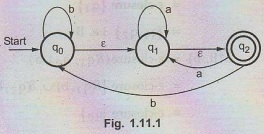
Solution:
Step 1: To convert this NFA we will first find ɛ-closures.
ε
- closures {q0} = {q0, q1, q2}
ε
- closures {q1} = {q1, q2}
ε
- closures {q2} = {q2}
Step
2:
Let us start from ε - closure of start state
ε
- closure {q0} = {q0, q1, q2} we
will call this state as A.
Now
let us find transitions on A with every input symbol.
δ
(A, a) = ε-closure (δ (A, a))
=
ε - closure (δ (q0, q1, q2), a)
=
ε - closure {(q0, a) U δ (q1, a) U δ (q2, a)}
=
ε - closure {q1}
=
{q1, q2). Let us call it as state B.
δ
(A, b) = ε-closure (δ (A, b))
=
ε - closure (δ (q0, q1, q2), b)
=
ε - closure {δ (q0, b) U δ (q1, b) U δ (q2, b)}
=
ε - closure {q0}
=
{q0, q1, q2} i.e. A.
Hence
we can state that,
δ'
(A, a) = B
δ`
(A, b) = A
Step
3:
Now let us find transitions for state B = {q1, q2}
δ'
(B, a) = ε - closure (δ (q1, q2), a)
=
ε - closure {q1}
=
{q1, q2} i.e. B
δ`
(B, b) = ε - closure (δ ( q1,
q2), b)
=
ε - closure {δ (q1, b) U δ (q2, b)}
=
ε - closure {q0}
=
(q0, q1, q2) i.e. A.
Step
4:
Hence the generated DFA is

Example
1.11.2 Convert the given NFA into its equivalent DFA -

Solution:
Let
us obtain ε - closure of each state.
ε
- closure (q0) = {q0, q1, q2}
ε
- closure (q1)= {q1, q2}
ε
- closure (q2) = {q2}
Now
we will obtain d' transition. Let e-closure (q0) = {q0, q1,
q2} call it as state A.
δ'
(A, 0) = ε - closure { δ ((q0, q1, q2), 0)}
=
ε - closure {δ (q0, 0) U δ (q1, 0) U δ (q2, 0)}
=
ε - closure {q0}
=
{q0, q1, q2} i.e. state A
δ' (A, 1) = ε - closure { δ ((q0, q1,
q2), 1)}
=
ε - closure {(q0,1) U δ (q1,1) U δ (q2,1)}
=
ε - closure {q1, q2}
=
{q1, q2} Call it as state B
δ'
(A, 2) = ε - closure {δ ((q0, q1, q2), 2)}
=
ε - closure {δ (q0, 2) U δ (q1, 2) U δ (q2, 2)}
=
ε - closure {q2}
=
{q2} Call it as state C.
Thus
we have obtained,
δ`
(A, 0) = A
δ`
(A, 1) = B
δ`
(A,2) = C
i.e.
Now
we will find transitions on states B and C for each input.
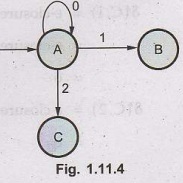
Hence,
δ'
(B, 0) = ε - closure {δ (q1, q2), 0}
=
ε - closure {δ (q1, 0) U δ (q2, 0)}
=
ε - closure {ϕ}
=
ϕ
δ'
(B, 1) = ε - closure {δ (q1, q2), 1}
=
ε - closure {δ (q1, 1) U δ (q2, 1)}
=
ε - closure {q1}
=
{q1, q2) i.e state B itself.
δ`
(B, 2) = ε - closure {δ (q1, q2), 2}
=
ε - closure {δ (q1, 2) U δ (q2, 2)}
=
ε - closure {q2}
=
{q2} i.e state C.
Hence,
δ`
(B, 0) = ϕ
δ`
(B, 1) = B
δ`
(B, 2) = C

The
partial transition diagram will be,
Now
we will obtain transitions for C:
δ`
(C, 0) = ε - closure {δ (q2, 0)}
=
ε - closure {ϕ}
=
ϕ
δ`
(C, 1) = ε - closure {δ (q2, 1)}
=
ε - closure {ϕ}
=
ϕ
δ`
(C,2) = ε - closure {δ (q2, 2)}
=
q2

Hence
the DFA is,
As
A = {q0, q1, q2} in which final state q2
lies hence A is final state in B = {q1, q2} the state q2
lies hence B is also final state in C = {q2}, the state q2
lies hence C is also a final state.
Example
1.11.3 Consider following NFA with ε.
AU:
May-11, Marks 6
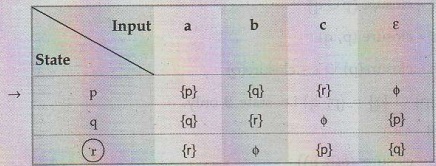
Convert
it to its equivalent DFA.
Solution:
We will first compute ε - closure for start state p.
ε
closure (p) = {p} call it as state A.
Now
we will obtain 8 transitions on state A.
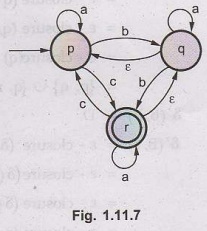
State
A
δ'
(A, a) = ε - closure (δ (A, a))
=
ε - closure (δ (p, a))
=
ε - closure (p)
=
{p} i.e. state A only.
δ'
(A, b) = ε - closure (δ (A, b))
=
ε - closure (δ (p, b))
=
ε - closure (q)
=
{q, p} i.e. {p, q} Let us call it state B.
δ'
(A, b) = B
δ'
(A, c) = ε - closure (δ (A, c))
=
ε - closure (δ (p, c))
=
ε - closure (r) = {q, r} Call it as state C.
State
B = {p, q}
δ'
(B, a)
=
ε - closure (δ (B, a))
=
ε - closure (δ (p, q), a)
=
ε - closure (δ (p, a) U δ (q, a))
=
ε - closure (p U q)
=
ε - closure (p, q)
=
ε - closure(p) Ụ ɛ - closure(q)
=
{P} U {q} = {p, q} i.e. state B only.
δ'
(B, a) = B.
δ'
(B, b) = ε - closure (δ (B, b))
=
ε - closure (δ (p, q), b)
=
ε - closure (δ (p, b) U δ (q, b))
=
ε - closure (q U r)
=
ε - closure (q, r)
δ'
(B, b) = ε - closure(q) U ε - closure(r)
=
{p, q} U {q, r} = {p, q, r} i.e. state D
δ`(B,
b) = D.
δ'
(B, c) = ε - closure (δ (B, C))
=
ε - closure (δ (p, q), c)
=
ε - closure (δ (p, c) U δ (q, c))
=
ε - closure (r U ϕ)
=
ε - closure (r)
=
{q, r}
δ'
(B, c) = C
State
C = {q, r}
δ'
(C, a) = ε - closure (δ (C, a))
=
ε - closure (δ (q, r), a)
=
ε - closure (δ (q, a) U δ (r, a))
=
ε - closure (q U r)
=
ε - closure (q) U ε - closure(r)
=
{p, q} U {q, r}
=
(p, q, r) i.e. state D.
δ'
(C, a) = D
8'
(C, b) = ε - closure (δ (C, b))
=
ε - closure (δ (q, r), b)
=
ε - closure (δ (q, b) U δ (r, b)).
=
ε - closure (r U ϕ)
=
ε - closure (r)
=
{q, r) i.e. state C.
δ'
(C, b) = C
δ'
(C, c) = ε - closure (δ (C, c))
=
ε - closure (δ (q, r), c)
=
ε - closure (δ (q, c) U δ (r, c))
=
ε - closure (ϕ U p)
=
ε - closure (p)
=
{p} i.e. state A.
δ'
(C, c) = A
State
D = {p, q, r}
δ'
(D, a) = ε - closure (δ (D, a))
=
ε - closure (δ (p, q, r), a)
=
ε - closure (δ (p, a) U δ (q, a) U δ (r, a))
=
ε - closure (p U q U r)
=
ε - closure (p) U ɛ - closure(q) U ε - closure (r)
=
(p, q, r) i.e. state D.
δ
' (D, a) = D
8'
(D, b) = ε - closure (δ (D, b))
=
ε - closure (δ (p, q, r), b)
=
ε - closure (δ (p, b) U δ (q, b) U δ (r, b))
=
ε - closure (q U r U ϕ)
=
ε - closure (q, r)
=
ε - closure (q) U ε - closure (r)
=
(p, q, r) i.e. state D.
δ'
(D, b) = D
δ'
(D, c) = ε - closure (δ (D, c))
=
ε - closure (δ (p, q, r), c)
=
ε - closure (δ (p, c) U δ (q, c) U δ (r, c))
=
ε - closure (r U ϕ U p)
=
ε - closure (r) U ε - closure (p)
=
{q, r} U {P}
=
{p, q, r} i.e. state D.
δ'
(D, c) = D
The
transition table from above calculations can be obtained as,
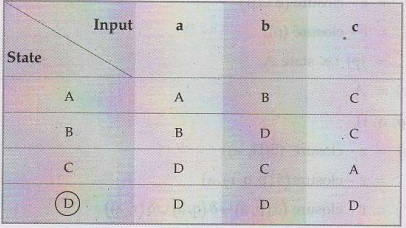
As
state A = {p} it is a start state and states C and D contain final state r,
hence these are final states. The transition diagram for the DFA is,
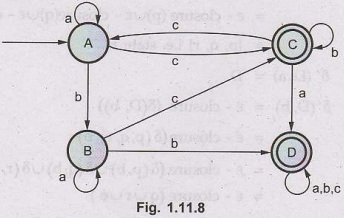
Example
1.11.4 Consider the following ε - NFA for an identifier.
Consider the ε -closure of each state and find it's equivalent DFA. AU:
Dec.-15, Marks 10
Solution:
ε
- closure (1) = {1} Call it as state
A
δ'
(A, letter) = ε - closure(δ (1, letter)
=
ε - closure(2)
= {2, 3, 4, 5, 8, 10} Call it as state B
δ'
(A, letter) = B
δ'
(A, digit) = ε - closure(δ (1, digit))
=
ϕ
δ'
(A digit) = ϕ
δ'
(B, letter) = ε - closure(δ (2, 3, 4, 5, 8, 10), letter)
=
ε – closure (6)
=
{6, 7, 4, 5, 8, 10) i.e.
=
{4, 5, 6, 7, 8, 10} Call it as state C
δ'
(B, letter) = C
δ'
(B, digit) = ε - closure(&(2, 3, 4,
5, 8, 10), digit)
=
ε – closure (9)
=
{9, 7, 4, 5, 8, 10} i.e.
=
{4, 5, 7, 8, 9, 10} Call it as state D
δ'
(B, digit) = D
δ'
(C, letter) = ε - closure(δ (4, 5, 6, 7, 8, 10), letter)
=
ε – closure (6)
=
C
δ'
(C, letter) = C
δ'
(C, digit) = ε - closure(δ (4, 5, 6, 7, 8, 10), digit)
=
ε – closure (9)
=
D
δ'
(C, digit) = D
δ'
(D, letter) = ε - closure(δ (4, 5, 7, 8, 9, 10), letter)
=
ε - closure (6)
=
C
δ'
(D, letter) = C
δ'
(D, digit) = ε - closure(δ (4, 5, 7, 8, 9, 10), digit)
=
ε - closure (9)
=
D
δ'
(D, digit) = D
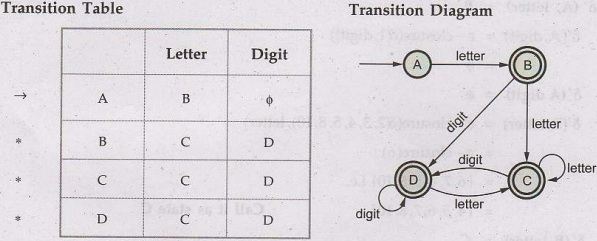
The
two states C and D are equivalent. Similarly state B and C are equivalent
B
= C = D.
The
minimized DFA will then be

Example
1.11.5 Convert the following ε - NFA to NFA and then
convert the resultant NFA to DFA.
AU
Dec.-18, Marks 13
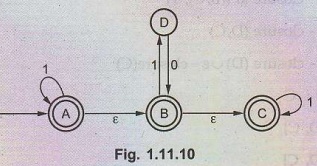
Solution:
Conversion of NFA to NFA
We
will obtain ɛ - closure of each state
ε
- closure (A) = {A, B, C}
ε
- closure (B) = {B, C}
ε
- closure (C) = {C}
ε
- closure (D) = {D}
Now
we will obtain δ' transitions for each state on each input symbol.
δ'
(A, 0) = ε - closure (δ (ε - closure(A), 0))
=
ε - closure (δ ((A, B, C), 0))
=
ε - closure (δ (A, 0) U δ (B, 0), U δ (C,0))
=
ε - closure (ϕ U ϕ U ϕ)
=
ϕ
δ'
(A, 0) = ϕ
δ'
(A, 1) = ε - closure (δ (ε - closure(A), 1))
=
ε - closure (δ (A, B, C), 1)
=
ε - closure (A, D, C)
=
ε - closure (A) U ε - closure (D) U ε - closure (C)
=
{A, B, C, D}
δ'
(A, 1) = {A, B, C, D}
δ'
(B, 0) = ε - closure (δ (ε - closure (B), 0))
=
ε - closure (δ (B, C), 0)
δ'
(B, 0) = ϕ
δ'
(B, 1) = ε - closure (δ (ε - closure (B), 1))
=
ε - closure (δ ((B, C), 1)
=
ε - closure (D, C)
=
ε - closure (D) U ε - closure(C)
=
D U C
=
{D, C}
δ'
(B, 1) = {D, C}
δ'
(C, 0) = ε - closure(δ (ε - closure(C), 0)
=
ε - closure (δ (C, 0)
=
ε - closure (ϕ)
δ'
(C, 0) = ϕ
δ'
(C, 1) = ε - closure (δ (ε - closure (C), 1)
=
ε - closure (δ (C, 1)
=
ε - closure (C)
=
{C}
δ'
(C, 1) = C
δ'
(D, 0) = ε closure (δ (ε - closure(D), 0))
=
ε - closure (δ (D, 0)
=
ε - closure (B)
δ'
(D, 0) = (B, C)
δ'
(D, 1) = ε - closure (8 (e-closure(D), 1))
=
ε - closure (δ (D, 1)
=
ε - closure (ϕ)
δ'
(D, 1) = ϕ
The
transition table will be
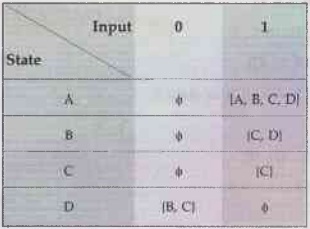
The
NFA will be:
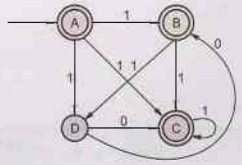
Conversion
of NFA to DFA
δ
(A, 0) = 0
δ
(A, 1) = {A, B, C, D} → call it as state P
δ
(A, 1) = p
δ
(P, 0) = P
=
δ ((A, B, C, D), 0)
=
δ (A, 0) U δ (B, 0) U δ (C, 0) U δ (D, 0)
{B,
C} → call it as state Q
S
(P, 0) = Q
δ
(P, 1) = δ ((A, B, C, D), 1)
=
δ (A, 1) U δ (B, 1) U δ (C, 1) U δ (D, 1)
=
{A, B, C, D}
δ
(P,1) = P
δ
(Q, 0) = δ ((B, C,), 0)
=
δ (B, 0) U δ (C, 0)
δ
(Q, 0) = ϕ
δ
(Q, 1) = ((B, C), 1)
=
δ (B, 1) U δ (C, 1)
=
{C, D} U {C}
=
{C, D} → call it as state R
δ
(Q, 1) = R
δ
(R, 0) = {δ (C, D), 0}
=
{B, C}
δ
(R, 0) = Q
δ
(R, 1) = δ ((C, D), 1)
δ
(R, 1) = {C}
δ
(C, 0) = ϕ
δ
(C, 1) = C
The
transition table will be

Review
Questions
1.
Let L be a set accepted by NFA then prove that there exists a deterministic
finite automaton that accepts L. Is the converse true? AU: May-05, Marks 10
2.
Prove that a language L is accepted by some ε - NFA if and only if L is
accepted by some DFA. AU: Dec.-06, Marks 8
Theory of Computation: Unit I: Automata and Regular Expressions : Tag: : Automata and Regular Expressions - Theory of Computation - Equivalence of NFA with ε to DFA
Related Topics
Related Subjects
Theory of Computation
CS3452 4th Semester CSE Dept | 2021 Regulation | 4th Semester CSE Dept 2021 Regulation
